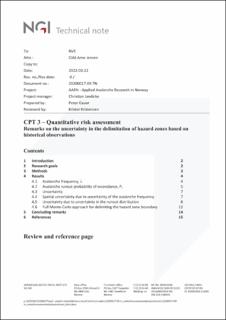CPT 3 – Quantitative risk assessment: Remarks on the uncertainty in the delimitation of hazard zones based on historical observations
Research report
Permanent lenke
https://hdl.handle.net/11250/3093118Utgivelsesdato
2022-03-22Metadata
Vis full innførselSamlinger
- NGI report [198]
Sammendrag
The Norwegian building code regulates the societal acceptable risk from avalanches for three building classes (S1, S1, and S3). The corresponding highest allowed nominal annual probabilities of avalanches reaching the building for these classes are set as 1/100, 1/1000 and 1/5000 respectively (TEK17, 2017). That is, avalanches should not reach a building, or the accompanying outdoor area and cause (considerable) damage more often than the building class permits. These hazard classes are used for delineation of avalanche hazard zones for land use planning (TEK17, 2017). For the assessment of the quantitative risk of avalanches reaching existing settlements only limited methods are available. Thus, historical observations can be of special importance, as they may be direct indicators for the real hazard in the area of interest. To a certain degree, they can also provide an indication of a possible change of hazard over time due to environmental changes. However, historical observations are affected by inherent uncertainties and many questions remain open. Here, we aim to combine results from several work packages to develop a more consistent method of using historical observations that may help improve quantitative hazard assessments and evaluation of the uncertainties involved.
